Swordfish
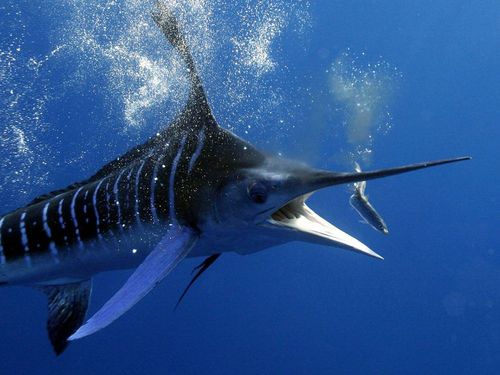
Swordfish have been fished widely since ancient times, among others in the sea between Sicily and Calabria, such as off the Tyrrhenian coast in the Reggio province. It is a typical dish in the cuisine of this region.
Swordfish were harvested by a variety of methods at small scale (notably harpoon fishing) until the global expansion of long-line fishing.
Swordfish are vigorous, powerful fighters. When hooked or harpooned, they have been known to dive so quickly that they have impaled their swords into the ocean bottom up to their eyes. Although there are no reports of unprovoked attacks on humans, swordfish can be very dangerous when harpooned. They have run their swords through the planking of small boats when hurt.
Tuna Fish
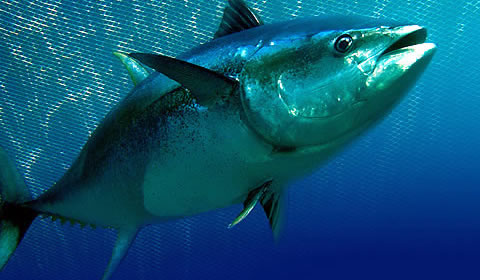
The tuna is a sleek and streamlined fish, adapted for speed. It has two closely spaced dorsal fins on its back; The first being “depressible”; – it can be laid down, flush, in a groove that runs along its back. Seven to 10 yellow finlets run from the dorsal fins to the tail, which is lunate – curved like a crescent moon – and tapered to pointy tips. The caudal peduncle, to which the tail is attached, is quite thin, with three stabilizing horizontal keels on each side. The tuna’s dorsal side is generally a metallic dark blue, while the ventral side, or underside, is silvery or whitish, for camouflage.
Mahi Mahi
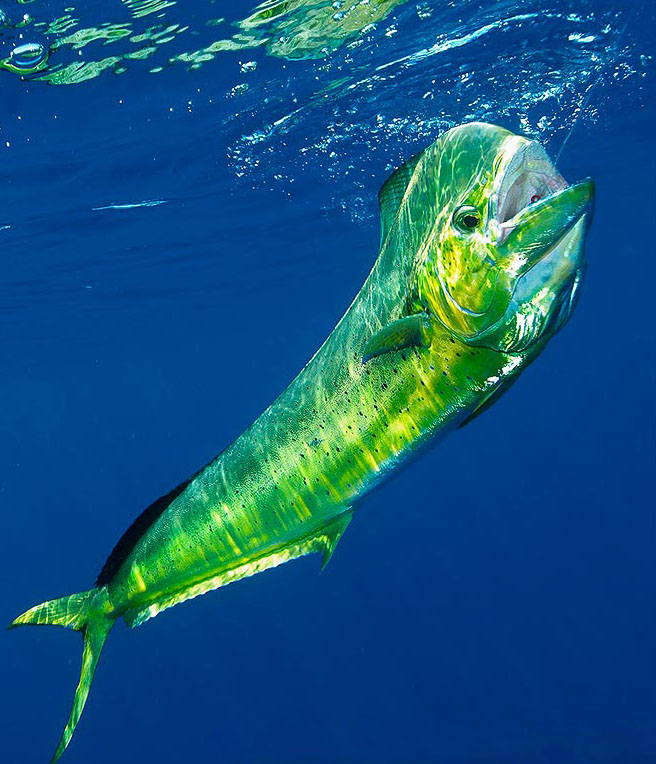
The mahi-mahi or common dolphinfish (Coryphaena hippurus) is a surface-dwelling ray-finned fish found in off-shore temperate, tropical and subtropical waters worldwide. Also known widely as dorado, it is one of only two members of the Coryphaenidae family, the other being the pompano dolphinfish. In other languages the fish is known as dorade coryphène, lampuga, lampuka, lampuki, rakingo, calitos, or maverikos.
Mahi-mahi can live up to 5 years (although they seldom exceed four). Catches average 7 to 13 kilograms (15 to 29 lb). They seldom exceed 15 kilograms (33 lb), and mahi-mahi over 18 kilograms (40 lb) are exceptional.
Mahi-mahi have compressed bodies and long dorsal fins extending nearly the entire length of their bodies. Their caudal fins and anal fins are sharply concave. They are distinguished by dazzling colors: golden on the sides, and bright blues and greens on the sides and back. Mature males have prominent foreheads protruding well above the body proper. Females have a rounded head. Females are also usually smaller than males.
Out of the water, the fish often change color among several hues (giving rise to their Spanish name, dorado, “golden”), finally fading to a muted yellow-grey upon death.
Amberjack
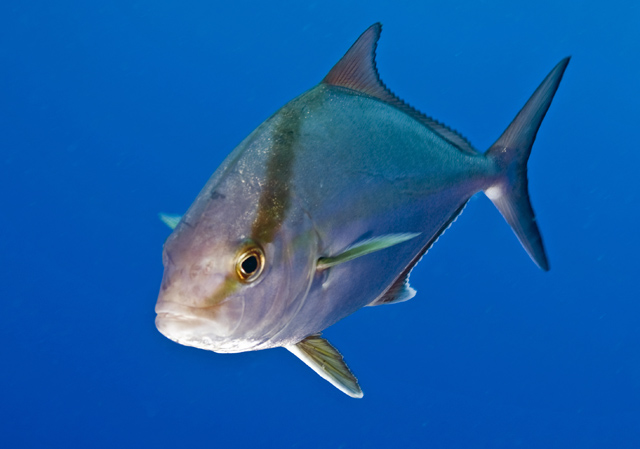
Amberjack refers to three species of Atlantic fish of the Carangidae family (genus Seriola), which includes the jacks and the pompanos.
Greater amberjacks, Seriola dumerili, are the largest of the jacks. They usually have dark stripes extending from nose to in front of their dorsal fins. They have no scutes and soft dorsal bases less than twice the length of the anal fin bases. They are usually 18 kg (40 pounds) or less, and are found associated with rocky reefs, debris, and wrecks, typically in 20 to 75 m (10 to 40 fathoms).
Lesser amberjacks, Seriola fasciata, have proportionately larger eyes and deeper bodies than greater amberjacks. They are olive green or brownish-black with silver sides, and usually have a dark band extending upward from their eyes. Juveniles have split or wavy bars on their sides. The adults are usually under 5 kg (10 lbs). They are found deeper than other jacks, commonly 50 to 130 m (30 to 70 fathoms).
Amberjacks are voracious predators, which feed on squid, fish, and crustaceans, and are thought to spawn offshore throughout most of the year.
Barracuda
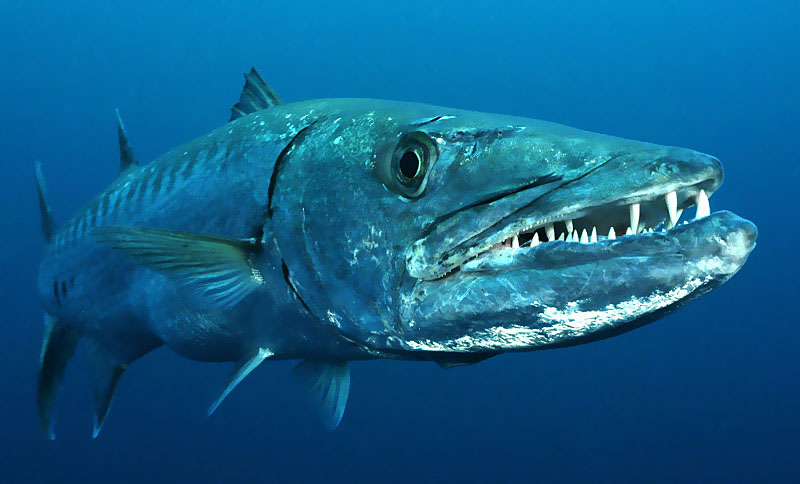
Barracudas are elongated fish, pike-like in appearance, with prominent, sharp-edged, fang-like teeth, much like piranhas, all of different sizes, set in sockets of their large jaws. They have large, pointed heads with an underbite in many species. Their gill covers have no spines and are covered with small scales. Their two dorsal fins are widely separated, with the anterior fin having five spines, and the posterior fin having one spine and 9 soft rays. The posterior dorsal fin is similar in size to the anal fin and is situated above it. The lateral line is prominent and extends straight from head to tail. The spinous dorsal fin is placed above the pelvic fins and is normally retracted in a groove. The caudal fin is moderately forked with its posterior edged double-curved and is set at the end of a stout peduncle. The pectoral fins are placed low on the sides. Its swim bladder is large.
In most cases, a barracuda is dark blue, dark green, or gray on its upper body, with silvery sides and a chalky-white belly. Coloration varies somewhat between species. For some species, irregular black spots or a row of darker cross-bars occur on each side. Their fins may be yellowish or dusky.
Black Bream
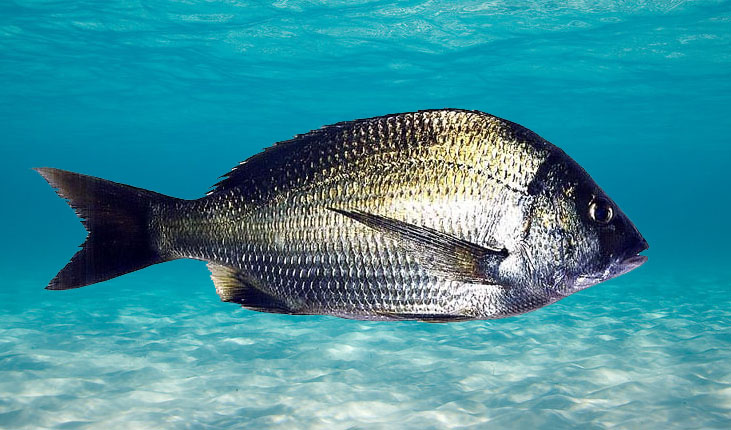
The Black Seabream (Spondyliosoma cantharus) is a species of Sparidae fishes. They are recognisable by their oval compressed body and jaws containing 4-6 rows of slender teeth which are larger at the front. They are silvery in colour with blue and pink tinges and broken longitudinal gold lines. They can reach a maximum size of 60 cm in length. They live in northern Europe and in the Mediterranean, usually found on the inshore shelf at depths varying from 5 to 300 m. They are usually found in schools feeding on seaweeds and invertebrates. They breed in February to May leaving eggs in the demersal zone.
Red Snapper & Grouper Snapper

Snappers are a family of perciform fish, Lutjanidae, mainly marine, but with some members inhabiting estuaries, feeding in freshwater. Some are important food fish. One of the best known is the red snapper.
Snappers inhabit tropical and subtropical regions of all oceans. They can grow to about 1 m (3.3 ft) in length. Most feed on crustaceans or other fish, though a few are plankton-feeders. They can be kept in aquaria, but mostly grow too fast to be popular aquarium fish. They live at depths reaching 450 m (1,480 ft).
About 100 species are currently recognized, divided into about 16 genera. A large number of species have “snapper” in their common names; most but not all are Lutjanidae. Nearly all of the 60 or so species in genus Lutjanus have common names that include the word “snapper”.

